The Featured Creatures collection provides in-depth profiles of insects, nematodes, arachnids and other organisms relevant to Florida. These profiles are intended for the use of interested laypersons with some knowledge of biology as well as academic audiences.
Introduction
The immigrant pavement ant, Tetramorium immigrans Santschi is one of the most commonly encountered ants in the United States. The first introduction into the United States occurred from Europe in the beginning of the 19th century. Since then, the species has become well established and is prevalent in urban areas in the northern U.S. and parts of Canada. While the presence of immigrant pavement ants in the U.S. has been acknowledged for decades, the extent of its invasiveness and severity as a pest are not well characterized.
Taxonomy
The immigrant pavement ant has a storied nomenclatural history, with specimens found in North America first identified as Tetramorium caespitum (L.). This characterization remained in place until a multidisciplinary study used genetic, phylogenetic, and morphological analysis to determine that the invasive Tetramorium species present throughout North America was in fact a distinct species from Tetramorium caespitum. These authors gave the species a temporary manuscript name of Tetramorium species E (Schlick-Steiner et al. 2006), which was used intermittently with the name T. caespitum in publications referring to this species during the subsequent twelve years (between 2006 and 2017).
In 2017, Wagner et al. definitively revised the European species of the Tetramorium caespitum complex and associated the ubiquitous non-native pavement ants in the Americas with the name Tetramorium immigrans Santschi, now fittingly referred to as the immigrant pavement ant.
Distribution
Pavement ants, genus Tetramorium Mayr, have a broad distribution within Europe. and T. immigrans was considered to have a very wide native range (Figure 1), extending from Spain to Turkey and Germany to Greece (Schlick-Steiner et al. 2006). However, Wagner et al. (2017) posited that the native distribution of T. immigrans was likely limited compared to its current range. Populations in Italy, Greece, and Turkey are now thought to represent expansion outside of the native range, and Moss et al. (2022) note that the range of T. immigrans in Europe appears to be expanding further.
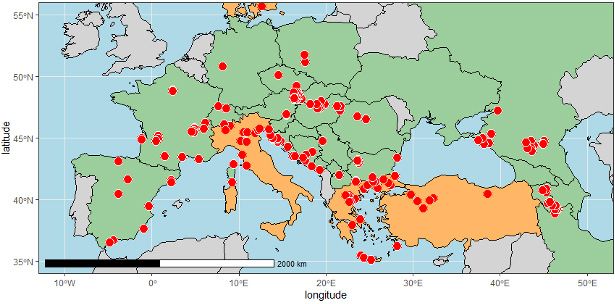
Credit: undefined
In North America, Tetramorium immigrans is found in urban areas in the northeastern United States, the Midwest, and the Pacific Northwest (Figure 2). Immigrant pavement ants have been found in urban areas in other U.S. states, as well. Whereas it was predicted in 2008 that the pavement ant could spread to 23 other U.S. states and 5 Canadian provinces, more recent literature demonstrates that the pavement ant can already be found in nearly half of these states (Steiner et al. 2008, Vanek and Potter 2010, Ellison et al. 2012). Zhang et al. (2019) found this species to be even more widespread in North America, established in 39 states in the continental U.S., as well as three Canadian provinces. Its outward spread from established areas in North America continues yearly (Helms et al. 2019, Moss et al. 2022).
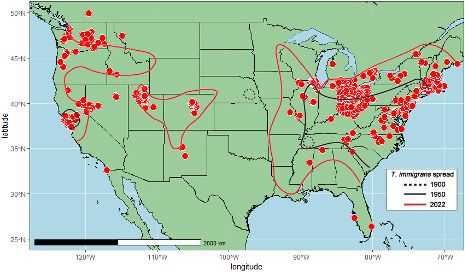
Credit: undefined
Using population genomics, Zhang et al. (2019) discovered that Tetramorium immigrans populations across North America have very low genetic diversity, suggesting that the entire population descended from one to a few closely related lineages that arrived approximately 200 years ago. They did not find evidence of inbreeding, which is commonly identified in other invasive ants. The relatively rapid and thorough spread of immigrant pavement ants throughout the continent is evidence of many occurrences of unintentional human transport.
Description
Immigrant pavement ant workers range in color from dark brown to nearly black. Workers are smaller than other castes (winged males and queens) and reach sizes of 2.75-3.20 mm. They are characterized by a head and thorax sculptured with longitudinal, parallel, or concentric fine ridges (rugae), pits with raised rims surrounding antennal insertions, 12-segmented antennae with three-segment club, a single pair of propodeal spines (Figure 4C), and a two segmented “waist” (petiole and post-petiole) (Fisher and Cover 2007, Ellison et al. 2012).
Head
The back margin of the clypeus (exoskeletal plate above the mandibles) descends near the antennae, creating a raised ridge between the antennal insertion and the mouthparts (Figure 3C). The antennae are twelve-segmented and terminate with a three-segmented club. Rugae run parallel up the front and sides of the head. Mandibles have seven teeth.
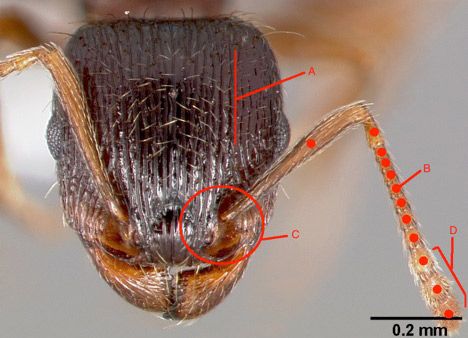
Credit: April Noble from www.AntWeb.org
Thorax and Abdomen
The thorax is sculptured with parallel (or concentric curved) rugae (Figure 4). A pair of spines extends from the propodeum (the first abdominal segment that is fused to the thorax). An anteroventral (front bottom) tooth (a small, pointed projection) is present on the pedicel (constriction) of the petiole. The petiole and post-petiole are roughly similar in shape (boxy) and size, with the postpetiole a little larger and glossier.
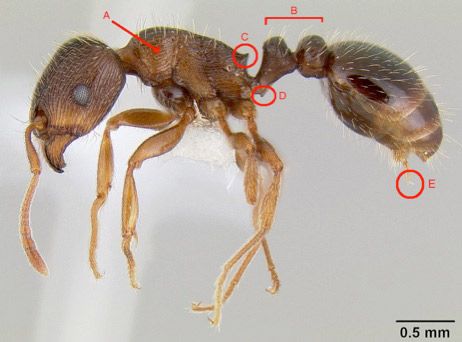
Credit: Michael Branstetter from www.AntWeb.org
Sting
These ants have a stinger that is modified and broadened distally (at the end) into a triangular ‘flag’, likely making this appendage less effective as a defensive stinger but providing more surface area for the application of trailing pheromone (Attygale and Morgan 1983) (as seen in Figure 4E). Pavement ants do not often sting humans.
In cities in Missouri and adjacent parts of Kansas and Illinois, the closely related species Tetramorium tsushimae Emery may be found, where it seems to outcompete and exclude Tetramorium immigrans wherever the former is established. It is difficult to distinguish these two species. Workers of Tetramorium immigrans are generally larger and have shorter propodeal spines than workers of Tetramorium tsushimae. Young workers of Tetramorium tsushimae, unlike those of Tetramorium immigrans, possess a lighter colored thorax in comparison to head and gaster, although their appearance becomes more uniform as they age (Steiner et al. 2006).
Biology and Behavior
Reproduction and Development
Pavement ants form large colonies, often containing over 10,000 workers. As with most ants, there are distinct castes in each colony: one or a few reproductive queens, and a large number of non-reproductive female workers. Much of the reproductive and developmental life history was recorded by Bruder and Gupta (1972). In early summer, winged reproductive females and males are produced. Mating occurs during nuptial flights in which alate (winged) reproductive ants leave colonies and mate in swarms. Generally, one sex predominates in the reproductives produced by a specific nest of pavement ants. It takes 42-63 days (at 21-24°C) for a fertilized egg to develop into a worker pavement ant in an established colony, although worker development occurs faster when a queen first starts a new colony.
Colonies of Tetramorium immigrans are usually monogynous - they are started by a single reproductive queen that carries out all reproduction for the lifetime of that colony - but they occasionally may have two, or possibly more, queens. Queen and colony longevity remain unknown (Moss et al. 2022). The majority of nests occupy 1.2-4.8 m2 in area and are 0.45-0.90 m deep (Bruder and Gupta 1972), with multiple crater-shaped mound entrances per nest. Mounds near entrances are not always obvious, as they are built up after rains but slowly collapse thereafter.
Foraging and Fighting
Workers recruit nestmates to a discovered food source through the use of pheromones. This allows for large groups of workers to process bulky food items and bring them back to the colony. Direct homing has been documented in worker ants of Tetramorium immigrans returning to the colony with food. Based on a reference light source and an awareness of the direction and distance they have traveled, Tetramorium immigrans workers can calculate a direct, straight-line path back to their colony while carrying food (Shen et al. 1998), making them very efficient foragers. Pavement ants are generalists, and their diet includes arthropods, honeydew from hemipterans, and seeds. In urban areas and crop fields, pavement ants are often observed foraging on discarded human food and vegetables and are often among the first ants to recruit to new food sources (Moss et al 2022). The average area over which a colony of Tetramorium pavement ants maintain a territory in their native range was estimated to be 43 m2 (Brian et al. 1967).
Large-scale skirmishes (Figure 5) between neighboring pavement ant colonies are common in the spring and beginning of summer when the ants are establishing their territories (Ellison et al. 2012). These territorial battles are attention-grabbing to passers-by, appearing as dark, writhing patches when they occur on sidewalks in urban environments.
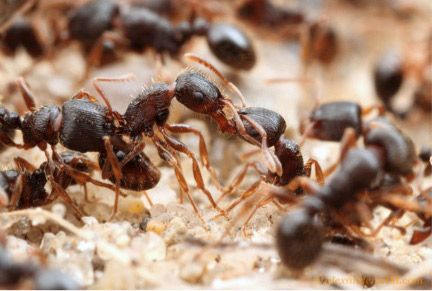
Credit: Alexander Wild, www.alexanderwild.com
Other Animal Associates
A known social parasite of Tetramorium immigrans colonies, Tetramorium atratulum (Schenck) (=Anergates atratulus), was also introduced into North America along with Tetramorium immigrans. Although Tetramorium atratulum is rare, it is broadly distributed and can be found from the eastern coast of the U.S. to as far west as Colorado (Helms et al. 2019). The social parasite has not been found in the Pacific coastal population of Tetramorium immigrans, which supports the conclusion that there were at least two introduction events to North America.
Several species of aphids, springtails, and mites have been found residing in pavement ant colonies in North America (Bruder and Gupta 1972). Nicoletiid Zygentoma (silverfish) are also commonly found in nests of this ant. Additionally, in the introduced range, nests of smaller ants like Monomorium minimum (Buckley) and Solenopsis molesta (Say) are often found near nests of pavement ants (Bruder and Gupta 1972).
Myrmecophilous (ant mutualist) lycaenid butterfly larvae can be found secreting carbohydrates in pavement ant nests, providing a food source for the ants in return for protection (Fiedler and Maschwitz 1998).
Habitat
Colonies of pavement ants can be found in several soil types ranging from sand to loam. Pavement ants prefer to nest in areas with minimal vegetation (Bruder and Gupta 1972), which makes them predisposed to favor urban habitat. Colonies have also been found in rotting wood. Immigrant pavement ants are also abundant in some agricultural landscapes (Helms et al. 2020)
In its introduced range, Tetramorium immigrans thrives in human-modified environments. In surveys of urban environments where immigrant pavement ants are found, they generally account for most ants found at baits and around residences (Buczkowski and Richmond 2012). These ants are also very resilient, being one of only a few species of ants found to recolonize an area after intensive human development, such as construction projects (Buczkowski and Richmond 2012).
In a survey of ant diversity on medians in New York City, Tetramorium immigrans was found to be the most abundant species (found on 93% of medians sampled) and was most common on smaller medians with fewer plants (Pećarević et al. 2010).
Economic Importance
Pavement ants are often considered invaders of homes because sidewalks, walkways, and patios make ideal habitat for these animals. However, it remains unclear whether these ants can infest homes with damaging consequences or whether inquisitive workers just become aesthetic pests when they make it into residences or are abundant on a patio. One record suggests that Tetramorium immigrans can be troublesome because they defend agricultural aphid pests (Merickel and Clark 1994), although pavement ants are less protective of aphids than other common ants (Katayama and Suzuki 2003). In Kentucky, Tetramorium immigrans have been documented to build protective structures made of soil around magnolia scale insects, significantly lowering the number of scales parasitized by flies and increasing damage to these plants (Vanek and Potter 2010). Ecologically, immigrant pavement ants may competitively exclude native ants from urban environments (Lessard and Buddle 2005).
Although Tetramorium immigrans is an introduced species, it may be beneficial in some scenarios. One example would be the potential for this ant to keep out more damaging ant invaders. In laboratory experiments, workers from colonies of Tetramorium immigrans destroyed recently founded colonies of the red imported fire ant, Solenopsis invicta Buren (King and Phillips 1992). Such conflict in nature may help to impede the northern expansion of fire ants and other invasive species.
In crop fields, Tetramoriumn immigrans have been identified as top predators, which suggests that they may play a role in agricultural pest suppression (Helms et al 2020). The pavement ant may also be an important ecosystem service provider in urban environments, by dispersing seeds, aerating soil, and recycling nutrients.
Management
Pavement ant workers can be nuisance pests when they enter homes and recruit colony members to accessible human food products or remnants. One of the most efficient ways to prevent pavement ants from entering homes is to locate and block potential entryways, and to keep homes clean, with food secured in sealed containers. Because Tetramorium ants engage in trophallaxis-based food sharing, liquid ant baits may be effective at reducing colony numbers and their presence inside the home.
For more information on ant management, see this guide: https://edis.ifas.ufl.edu/publication/ig080.
Selected References
Attygalle AB, Morgan ED. 1983. Trail pheromone of the ant Tetramorium caespitum L. Naturwissenschaften 70: 364-365.
Bharti H, Kumar R. 2012. Taxonomic studies on genus Tetramorium Mayr (Hymenoptera, Formicidae) with report of two new species and three new records including a tramp species from India with a revised key. ZooKeys 207: 11.
Brian MV, Elmes GW. 1974. Production by the ant Tetramorium caespitum in a southern English heath. The Journal of Animal Ecology 43: 889-893.
Bruder KW, Gupta AP. 1972. Biology of the pavement ant, Tetramorium caespitum (Hymenoptera: Formicidae). Annals of the Entomological Society of America 65: 358-367.
Buczkowski G, Richmond DS. 2012. The effect of urbanization on ant abundance and diversity: A temporal examination of factors affecting biodiversity. PloS One 7: e41729.
Dash ST, Sanchez L. 2009. New distribution record for the social parasitic ant Anergates atratulus (Schenck, 1852) (Hymenoptera: Formicidae): An IUCN Red-Listed species. Western North American Naturalist 69: 140-141.
Ellison AM, Gotelli NJ, Farnsworth EJ, Alpert GD. 2012. A field guide to the ants of New England. Yale University Press. 332 p.
Fiedler K, Maschwitz U. 1988. Functional analysis of the myrmecophilous relationships between ants (Hymenoptera: Formicidae) and lycaenids (Lepidoptera: Lycaenidae). Oecologia 75: 204-206.
Fisher BL, Cover SP. 2007. Ants of North America: A guide to the genera. University of California Press. pp. 25-40, 148-159.
Garcia FH, Fisher BL. 2014. The hyper-diverse ant genus Tetramorium Mayr (Hymenoptera, Formicidae) in the Malagasy region taxonomic revision of the T. naganum, T. plesiarum, T. schaufussii, and T. severini species groups. ZooKeys 413: 1-170.
Guénard B, Weiser MD, Gómez K, Narula N, Economo EP. 2017. The Global Ant Biodiversity Informatics (GABI) database: synthesizing data on the geographic distribution of ant species (Hymenoptera: Formicidae). Myrmecological News 24: 83-89.
Helms JA, Ijelu, SE, Haddad NM. 2019. Range expansion in an introduced social parasite-host species pair. Biological Invasions 21: 2751-2759.
Helms JA, Roeder KA, Ijelu, SE, Ratcliff I, Haddad NM. 2020. Bioenergy landscapes drive trophic shifts in generalist ants. Journal of Animal Ecology 90: 738-750.
Helms JA, Ijelu SE, Wills BD, Landis DA, Haddad NM. 2020. Ant biodiversity and ecosystem services in bioenergy landscapes. Agriculture, Ecosystems and Environment 290:106780.
Katayama N, Suzuki N. 2003. Bodyguard effects for aphids of Aphis craccivora Koch (Homoptera: Aphididae) as related to the activity of two ant species, Tetramorium caespitum Linnaeus (Hymenoptera: Formicidae) and Lasius niger L. (Hymenoptera: Formicidae). Applied Entomology and Zoology 38: 427-433.
King TG, Phillips Jr. SA. 1992. Destruction of young colonies of the red imported fire ant by the pavement ant (Hymenoptera: Formicidae). Entomological News 103: 72-77.
Lessard JP, Buddle CM. 2005. The effects of urbanization on ant assemblages (Hymenoptera: Formicidae) associated with the Molson Nature Reserve, Quebec. Canadian Entomologist 137: 215-225.
Merickel FW, Clark WH. 1994. Tetramorium caespitum (Linnaeus) and Liometopum luctuosum WM Wheeler (Hymenoptera: Formicidae): New state records for Idaho and Oregon, with notes on their natural history. Pan-Pacific Entomologist 70: 148-158.
Moss AD, Swallow JG, Greene MJ. 2022. Always under foot: Tetramorium immigrans (Hymenoptera: Formicidae), a review. Myrmecological News 32: 75-92.
Pećarević M, Danoff-Burg J, Dunn RR. 2010. Biodiversity on Broadway-enigmatic diversity of the societies of ants (Formicidae) on the streets of New York City. PLoS One 5: e13222.
Schlick-Steiner BC, Steiner FM, Moder K, Seifert B, Sanetra M, Dyreson E, Staffer C, Christian E. 2006. A multidisciplinary approach reveals cryptic diversity in Western Palearctic Tetramorium ants (Hymenoptera: Formicidae). Molecular Phylogenetics and Evolution 40: 259-273.
Steiner, FM, Schlick-Steiner BC, Trager JC, Moder K, Sanetra M, Christian E, Stauffer C. 2006. Tetramorium tsushimae, a new invasive ant in North America. Biological Invasions 8(2):117-123.
Sharaf MR, Aldawood AS, Taylor B. 2012. A new ant species of the genus Tetramorium Mayr, 1855 (Hymenoptera: Formicidae) from Saudi Arabia, with a revised key to the Arabian species. PLoS One 7: e30811.
Shen JX, Xu ZM, Hankes E. 1998. Direct homing behaviour in the ant Tetramorium caespitum (Formicidae, Myrmicinae). Animal Behaviour 55: 1443-1450.
Steiner FM, Schlick-Steiner BC, VanDerWal J, Reuther KD, Christian E, Stauffer C, Suarez A, Williams S, Crozier RH. 2008. Combined modelling of distribution and niche in invasion biology: A case study of two invasive Tetramorium ant species. Diversity and Distributions 14: 538-545.
Vanek SJ, Potter DA. 2010. An interesting case of ant-created enemy-free space for magnolia scale (Hemiptera: Coccidae). Journal of Insect Behavior 23: 389-395.
Wagner HC, Arthofer W, Seifert B, Muster C, Steiner FM, and Schlick-Steiner BC. 2017. Light at the end of the tunnel: Integrative taxonomy delimits cryptic species in the Tetramorium caespitum complex (Hymenoptera: Formicidae). Myrmecological News 25: 95–129.
Wagner HC, Gamisch A, Arthofer W, Moder K, Steiner FM, Schlick-Steiner BC. 2018. Evolution of morphological crypsis in the Tetramorium caespitum ant species complex (Hymenoptera: Formicidae). Sci Rep 8, 12547 (2018). https://doi.org/10.1038/s41598-018-30890-z
Zhang YM, Vitone TR, Storer CG, Payton AC, Dunn RR, Hulcr J, McDaniel SF, Lucky A. 2019. From pavement to population genomics: characterizing a long-established non-native ant in North America through citizen science and ddRADseq. Frontiers in Ecology and Evolution. 7: 453.